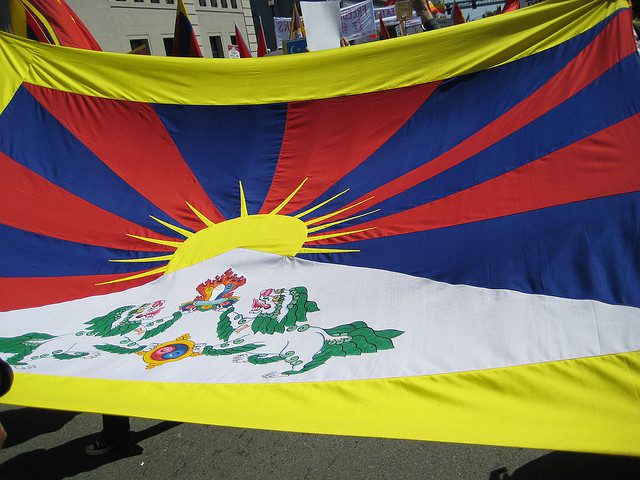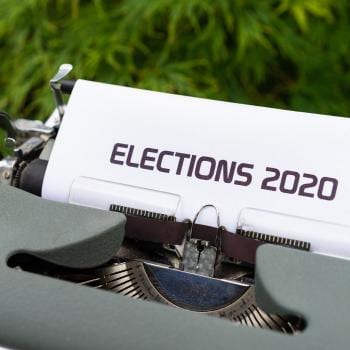Today is the 56th anniversary of the March 10, 1959 start of the Tibetan uprising against Chinese occupation. The history around that day is outlined below, but first, in today’s news the Associated Press (via MB and BBC World News) reports that:
Indian police have detained about 100 Tibetans who were protesting outside the Chinese Embassy in New Delhi on the anniversary of a failed 1959 uprising against China’s rule in Tibet.
Protesters interlocked their hands and tried to form a chain around the embassy before police stepped in and dragged them away.
Protesters are expected to be released later today. The protesters dedicated their actions to the more than 130 Tibetan men and women who have died in self-immolations since 2009. According to the International Campaign for Tibet, similar events are planned for capitals and major cities around the world.

From Tibet.org, the following timeline depicts the events that March:
On March 1, 1959, while the Dalai Lama was preoccupied with taking his Final Master of Metaphysics examination, two junior Chinese army officers visited him at the sacred Jokhang cathedral and pressed him to confirm a date on which he could attend a theatrical performance and tea at the Chinese Army Headquarters in Lhasa. The Dalai Lama replied that he would fix a date once the ceremonies had been completed
This was an extraordinary occurrence for two reasons: one, the invitation was not conveyed through the Kashag (the Cabinet) as it should have been; and two, the party was not at the palace where such functions would normally have been held, but at the military headquarters – and the Dalai Lama had been asked to attend alone.
March 7, 1959. The interpreter of General Tan Kuan-sen – one of the three military leaders in Lhasa rang the Chief Official Abbot demanding the date the Dalai Lama would attend their army camp. March 10 was confirmed.
March 8, 1959. This was Women’s Day, and the Patriotic Women’s Association was treated to a harangue by General Tan Kuan-sen in which he threatened to shell and destroy monasteries if the Khampa guerrillas refused to surrender. “… we knew that the ordinary people of Lhasa were being driven to open rebellion against the Chinese though they would have to fight machine-gunners with their bare hands”, writes Mrs. Rinchen Dolma (Mary) Taring in her autobiography, Daughter of Tibet.
March 9, 1959. At 8.00 am two Chinese officers visited the commander of the Dalai Lama bodyguards’ house and asked him to accompany them to see Brigadier Fu at the Chinese military headquarters in Lhasa. Brigadier Fu told him that on the following day there was to be no customary ceremony as the Dalai Lama moved from the Norbulinka summer palace to the army headquarters, two miles beyond. No armed bodyguard was to escort him and no Tibetan soldiers would be allowed beyond the Stone Bridge – a landmark on the perimeter of the sprawling army camp.
By custom, an escort of twenty-five armed guards always accompanied the Dalai Lama and the entire city of Lhasa would line up whenever he went. Brigadier Fu told the commander of the Dalai Lama’s bodyguards that under no circumstances should the Tibetan army cross the Stone bridge and the entire procedure must be kept strictly secret.
The Chinese camp had always been an eyesore for the Tibetans and the fact that the Dalai Lama was now to visit it would surely create greater anxiety amongst the Tibetans.
March 10, 1959. The invitation provoked 30,000 loyal Tibetans to surround the Norbulinka palace, forming an human sea of protection for their Yeshe Norbu (nickname for the Dalai Lama, meaning “Precious Jewel”). They feared he would be abducted to Beijing to attend the upcoming Chinese National Assembly. This mobilization forced the Dalai Lama to turn down the army leader’s invitation. Instead he was held a prisoner of devotion.
March 12, 1959. 5,000 Tibetan women marched through the streets of Lhasa carrying banners demanding “Tibet for Tibetans” and shouting “From today Tibet is Independent”. They presented an appeal for help to the Indian Consulate-General in Lhasa.
Mimang Tsongdu members and their supporters had erected barricades in Lhasa’s narrow streets while the Chinese militia had positioned sandbag fortifications for machine guns on the city’s flat rooftops. 3000 Tibetans in Lhasa signed their willingness to join the rebels manning the valley’s ring of mountains.
On March 15, 3000 of the Dalai Lama’s bodyguards left Lhasa to position themselves along an anticipated escape route. Khampa rebel leaders moved their most trusted men to strategic points. Stalwarts of the Tibetan Army merged with civilians to cover the chosen route. By this time the Tibetans were out-numbered 25 to 2. An estimated 30,000 to 50,000 Chinese troops wielded modern weapons and had 17 heavy guns surrounding the city. While the Chinese manned swiveling howitzers, the Tibetans were wielding cannons into position with mules.
March 16, 1959. Chinese heavy artillery was seen being moved to sites within range of Lhasa and particularly the Norbulinka. Rumours were rife of more troops being flown in from China. By nightfall Lhasa was certain that the Dalai Lama’s palace was about to be shelled.
March 17, 1959 4 pm. The Chinese fired two mortar shells at the Norbulinka. They landed short of the palace walls in a marsh. This event triggered the Dalai Lama to finally decide to leave his homeland.
And for a thoughtful discussion on the Future of Tibet, see this video of a panel on that topic, held at Bard College in February 2013 (since little has changed in the official status of Tibet-China relations, it is still a very timely video):
You can read more about the panel and its participants here.












